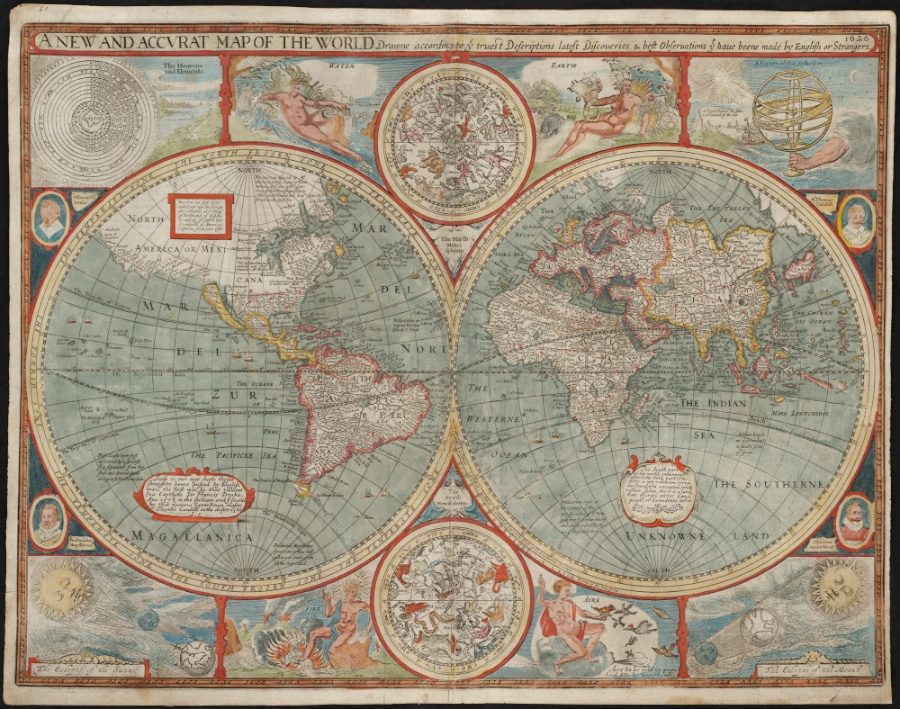In the past few months we have revisited our fundamental identity as an organization. We are the World Mission Prayer League. A committed community — this makes us a “league.” With a “working method” — we pray. Commissioned to gospel service and proclamation — this is our mission. This month we arrive at a fourth and final component — the “w” in our name. Our field is the world.

(courtesy of the Norman B. Leventhal Map Center at the Boston Public Library)
But we do not mean geography.
It is customary — it is almost irresistible, I think — to understand the missionary mandate in terms of geography. We picture globes with little bumps raised for the Himalayas. We picture nations in shades of pastel color, sketched in two dimensions on poster board. We picture airports and train depots, passports and visas — and hours and days of travel to places very far away. A century ago, a raft of newly formed missionary organizations epitomized this geographical emphasis. There were “inland” missions headed for the geographic interiors of continents and nations. There were “regions beyond” missions aiming at geography outside our normal view. Our own organization was a product of this movement. We pictured a movement of Lutherans to the “unreached interiors” of the faraway continents of the world. Our founders sketched their vision on maps.
It is still easy to understand the mandate in this way. Consider our reading of passages like Acts 1:8. Our Lord has made us his witnesses “in Jerusalem, in all Judea and Samaria, and to the ends of the earth.” We are likely to picture a simple geographical progression: we are in Jerusalem at the center of things; out from us go concentric circles of activity, to places like “Judea” and “Samaria”; and at the end of the progression, very far away, are “the ends of the earth.”
But what if the progression were not so simple? What if, in particular, we were not the center of the circle? Why, “the ends of the earth” might be nearer than we thought!
Actually, the “world” of our missionary mandate has little to do with geography. The mandate has to do with peoples, not nation states. Abraham was called to participate in the blessing of God to all peoples (Genesis 12:1-3). The focus is on cultures, ethnicities, tribes and tongues. Jesus sent his followers to make disciples of all peoples (Matthew 28:19-20). He did not mean circles on a map; he meant human beings. And at the end of time, “tribes and peoples and languages” will gather around the throne of the Lamb (Revelation 7:9). Peoples are the target of our missionary mandate.
This may seem an altogether obvious insight. But it is important to call it to mind.
For one thing, a “people-centered” understanding of the mandate puts the task into perspective — and immediately at hand. You don’t have to travel to “the ends of the earth” to find peoples or cultures unreached by the gospel. You will find them right outside your door. A “people-centered” approach helps us to set priorities, too. We are not more or less faithful because of the distances we travel. We are faithful as we identify peoples who need to know the Savior. Pashtu speakers here in Minneapolis — and away in Central Asia. Bahah peoples in Chicago — and on South Asian islands. When peoples come into focus, we will learn to see them wherever they are.
Once we lose a geographical understanding of our mandate we might notice, too, that there are other “Jerusalems” nowadays. The center of the circle is no longer in Palestine. And it is no longer in Minneapolis, or Chicago, or Los Angeles, either. The mission of God has enlisted the sisters and the brothers from many “Jersualems” around the world. In fact, wherever we find the sisters and brothers, we find another sending center, potentially — another “Jerusalem.”
So our field is the world: we are the World Mission Prayer League. We want to have peoples always in view — yes, the same peoples that we pray to see one day gathered around the throne.